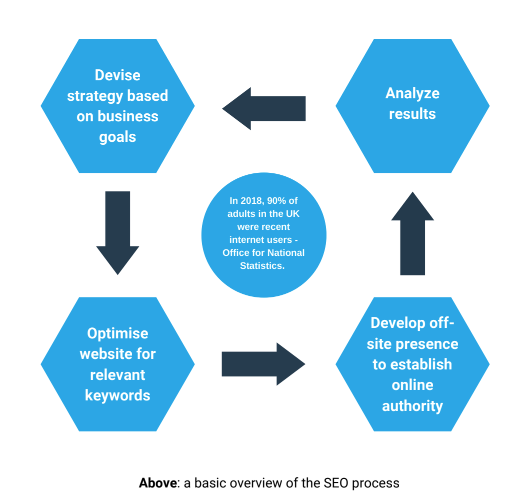What is Content Marketing?
Here at Active Internet Marketing, we firmly believe that content marketing is a vital component of any digital marketing strategy. Why? The answer to such a question is long and exhaustive, but over the course of this article you will understand what content marketing is as well as the importance of a solid content marketing strategy.
For now, just know that when done right, content marketing has the potential to bring unrivaled traffic to your site, resulting in increased exposure and authority for your brand, happy users, and, ultimately, more conversions.
Content Marketing Defined
Content marketing is the process of creating content to share with your target audience. Generally, it refers to the creation of specific, tailored content to target certain groups or types of people.
What are examples of content marketing?
‘Content’ is really just an umbrella term for a piece of material designed to engage an audience. Popular forms of online content include written pieces (often in the form of blog posts), images, videos, infographics, GIFs and much more. The type of content you choose will vary depending on your industry, target audience, and goals for that particular piece of content.
Take a look at some of the best examples of content below.
1) Blog posts/articles
For many businesses, a steady stream of written content is the bread and butter of a solid content marketing strategy. Written content is a great way to widen your net and target some query-based searches. Posts should be highly informative and establish your business as an authority on any given subject. If you can target queries/ information-based searches and rank for them, all the better.


If you are looking to update your website regularly, then pieces of well written content of between 300 and 500 words can often work well. However, if you are truly looking to rank consistently and become a powerhouse of authority in your industry, then in-depth, researched articles of at least 1000 words are the way to go. This shows Google that you are an expert in your industry, and indicates that you care about your customers enough to provide them with truly valuable content. As long as the piece is well written and informative, there’s no reason why you should not outrank those blogs that have settled for shorter, less informative pieces.
Top Tip: Target long-tail keywords with your written content to bring new users to your website. Long-tail keywords usually have fewer monthly searches but are more likely to lead to conversions.
2) Video
We all know that the average attention span is dwindling fast. In an age where YouTube dominates the online space (nearly FIVE BILLION videos are watched per day), it’s in the best interests of business owners to create video content that is relatively short, entertaining on both the eyes and the ears, and easy to digest (because who likes reading, right?).
Additionally, because many users will prefer to digest content visually, videos are more likely to be shared on social media channels. Indeed, the algorithms of many social media platforms actively push video content in front of users because they know it’s what the majority of people are after.
Videos can also be embedded into social media posts, which means users can consume the content without ever leaving the platform (great for Facebook and Twitter, less great for businesses trying to generate traffic to their site!). That being said, video content on social media is a great recipe for going viral, so if you can create a piece of video that’s incredibly popular, you’re likely to see an increase in traffic anyway.


Videos are a great way to target younger audiences in particular. It’s generally thought that users under the age of 35 (Millennials, General Z, and whatever comes next…) prefer video content, which means there’s a tonne of industries that could benefit from a solid video content strategy. Ultimately, videos are great for those occasions where you want to get information across quickly and efficiently.
Top Tip: Adding a transcript to your video can significantly bolster its SEO potential. You could
3) Infographics
Infographics have really blown up in recent years, and with good reason. They are a great way of combining data or other important information with visual media to create a lasting impression. When done properly, infographics can educate, entertain, and engage, all in a single image!
Infographics work well by themselves or when combined with other types of content. Keep them simple and avoid clutter; the key here is to communicate the most relevant, important information in the most effective way possible.


When designing an infographic, it’s important to consider key elements of graphic design, such as layout, colour, fonts, and more. For example, the clever use of images to support any words or numerical data will help embed your message in the mind of anyone who sees it. If you are serious about sharing high-quality infographics with the world, then it might be worth employing a graphic designer to help bring your vision to life.
Top Tip: When relevant, consider embedding infographics into your written content. This will help you obtain those elusive Featured Snippets!
4) Whitepapers
White papers effectively take blog posts and articles to the next level. They need to be highly informative, thoroughly researched, and based on facts. A white paper should provide an in-depth guide to a subject and educate the audience without a sales agenda.
Indeed, while the ultimate goal of a whitepaper is to generate leads, this should be achieved through offering content of genuine use and/or interest to the reader, who will then trust you enough to use your products or services. It’s fine to have a bit of information about your company at the beginning of the whitepaper (otherwise, how will readers know you’re worth your salt?), but this should be brief.
The best whitepapers have a combination of excellently written content and top-notch visual design. They should make good use of page space through high-quality photographs and images, and important data or statistics should be represented in an infographic or chart.
Top Tip: Remember, whitepapers are not books or essays. Visuals are just as important as text.
5) Newsletters
When done correctly, newsletters are an invaluable tool for any business. They are a way of bypassing all barriers, and providing a steady drip-feed of your brand straight into your customer’s inbox. As long as you can keep them engaged with the content in your newsletter, it’s a sure way of keeping customers on board for life.
Newsletters can be difficult to start from scratch. After all, how can you send an email without any email addresses? This isn’t too much of an issue for e-commerce sites, as you can require customers to have an account (with an email address attached) in order for them to make a purchase.


Any other websites, however, will require a bit more creativity. We find that incentives are a sure way to get an influx of users to sign up to your mailing list. A discount? A freeby? It doesn’t need to be much, but who doesn’t like free stuff?
Once you’ve got users signed up, you need to stop them from clicking the dreaded ‘unsubscribe’ button. You do this by ensuring that your emails are packed full of quality content. Again, if you can incentivise the customer to stay subscribed (through the promise of discounts or competitions), then all the better. That being said, if your emails are made up of genuinely good content, you shouldn’t need to offer any monetary compensation!
Top Tip: We all know the importance of recycling, and emails are a great way to recycle old content. For example, you can find many ways to link to older blog posts via email marketing.
What are the benefits of content marketing?
Although you’re now aware of some of the more popular and effective types of content, we’re sure there’s still one burning question at the forefront of your mind.
What’s the point?
Or, more specifically: Why spend the time and effort on creating content people want? What is in it for me? What value does it bring to my business?
These are all valid questions. After all, time is money, and if you’re investing a serious amount of time into a content marketing strategy, it’s only fair that you’ll want to see something in return. Well, the reason we’re so passionate about fantastic content marketing strategies is because, when done right, they can bring invaluable benefits to your business.
Become an authority in your industry
One of the core foundations of a solid business is credibility. While credibility is primarily built through providing a great service or product to your customers, what if there was a way to earn somebody’s trust before they become a paying customer? For many businesses, consumer reluctance is a significant barrier to overcome.
Creating quality content allows you to get ahead of the competition by demonstrating to your potential (or existing) customers that you know your stuff. Taking the time to delve deep into a topic or offer expert advice will highlight your expertise in the industry, and steer customers in your direction. Over time, users will look to you as their primary source of information in your industry.
Similarly, creating high-quality content in the form of well designed images or informative whitepapers puts your brand a cut above the competitors who have opted for amateur designs.
Top Tip: Aim for featured snippets to become a true authority in your industry.
Dominate the search engines
Speaking of getting ahead of the competition, a well thought out content strategy could result in your website dominating page 1 on Google. As we mentioned earlier in the article, aiming for long-tail keywords in your content is the most effective way to earn those coveted page 1 rankings. More specific queries are searched less frequently than generic queries, which results in less competition.


With that being said, once you’ve got the hang of writing high quality content, there is no reason why you should not be able to rank well for those short-tail – or generic – keywords. After all, somebody has got to be on page 1, why shouldn’t it be you?
With a proper plan and careful keyword research, before long your content will be sprouting up across the web for a variety of search queries.
Top Tip: Written content over 1000 words has a significantly better chance of ranking well than shorted pieces. That doesn’t mean you should include a lot of ‘fluff’ though; the 1000+ words should be of high quality.
Reach new audiences (and customers!)
By creating a wide variety of content, you’ll increase your digital footprint and spread those digital tendrils deeper and wider into the internet. It means that people who are interested in your industry, but have never heard of your brand, have a better chance of stumbling across your website organically.
If those users like what they see, they’ll be more likely to link your content to a friend or colleague, who could then link it to two friends or colleagues, and so on.
Although you don’t want to be over ‘salesy’, make it clear in your content who you are and what services you provide. This will make new audiences more likely to convert in the future.
Top Tip: You can ‘make it clear’ by talking a bit about your business in your Call To Action (CTA), or by adding internal links to your product or service pages.
Offer value
It’s not unreasonable to view your content as another service you provide for your customers. This is especially true for long-form blog content and whitepapers, which will often provide in-depth information on a topic that users wouldn’t otherwise have access to. The only difference with this service is that it is free of charge.
Top Tip: Offer even more value by offering exclusive discounts to the users who read your content.
Retain your customers
While a customer converting is fantastic, the key to success and long-term viability of a business is customer retention. Providing a great product or service should hopefully result in customers returning again and again, but your content can definitely supplement your retention plans.


For example, if you are committed to putting out useful content monthly (or even better, weekly!), it’s in your audience’s best interests to return to your website regularly. Similarly, if you share your content across social media, you can build a relationship with your customers through conversation and interaction.
Top Tip: One of the most impactful ways of retaining customers is through weekly emails. Depending on your industry, you can send offers, news, competitions, and other pieces of content directly to your customer’s inbox.
Content Marketing In Context
So how might content marketing actually look in practice? Let’s take a look at our own hypothetical company – ‘Molly’s Boutique’.
Imagine you are the owner of ‘Molly’s Boutique’, an independent boutique clothing company. As every business owner is, you’re eager to make more sales. You decide it could be a good idea to develop a content marketing strategy.
Firstly, you would need to identify a target audience – for this example, we’ll go with females between the ages of 25-35. The most important thing is that your content helps these people. They’re the only ones that matter with this kind of targeted content marketing. Sure, the wider campaign will focus on a range of different demographics and you’ll need to bring all of that together somehow, but each individual piece should have a very specific, targeted group in mind.
To successfully market using content, you have to become a resource. You need to show people that you’re an expert, an authority, and a trustworthy source of information. One of the most effective ways of doing this is by successfully targeting a demographic. If you can create content that genuinely helps people in a certain situation, you’ve done a good job. So, what sort of content – based around the boutique clothing industry – might appeal to females aged between 25-35?
Blog posts are always a great place to start. With a bit of research into the demographic and current trends, we’ve come up with two potential titles:
- Spring to Spring: How to Adapt your Fashion for Each Season
- What Does Your Star Sign Tell You about Your Style?
- 6 New Styles to Try This Summer
Remember that the premise of content marketing is a relatively simple one: to inform and entertain with no strings attached so that users come to trust you. It’s all about establishing your company, and your brand, as an indispensable asset for customers – and that’s it.


What Does the Content Marketing Process Look Like?
We’ve spent many years putting together hundreds of content marketing campaigns for our clients, so it’s safe to say we’ve learned a few things along the way. With that in mind, we’ve broken down our strategy into a 4-step process to offer some insight into how we craft successful content and campaigns.
While you will want to create different types of content, target different audiences, and hit different objectives over the course of a month, quarter, or year, these core steps should remain the same throughout. So, returning to Molly’s Boutique as our example, let’s take a look!
Molly’s 4-Step Process
Step 1 – Establish Target Audience & Carry Out Market Research
Molly knows that the vast majority of customers who purchase clothes from her store are women between the age of 25-35. Therefore, she makes it her mission to gather as much data as she can about this demographic.
Step 2 – Identify Subject and Establish an Effective Content Type
Molly conducts keyword research to establish the sort of queries users are searching for. She may decide to base her content around a common search query, which will be extremely competitive to rank for. Molly will need to spend a lot of time and effort on creating a well researched, informative, top-class piece of content if she has hopes of competing with the top dogs.
Alternatively, Molly could target long-tail keywords: a type of query that is more specific – and thus searched less often – but much easier to rank for. Any good content marketing strategy will understand the true value of long-tail keywords, as they generally bring in better quality traffic.
Even if Molly doesn’t want to write a blog, keyword research is an essential part of the process as she needs to understand what subject to base her videos, infographics and whitepapers on.
From her demographic research, Molly knows that the people who tend to shop at her store have a higher disposable income than average, and tend to buy new clothes at least once per week. From her keyword research, she knows that users across the country are always seeking information online about the newest trends. She therefore decides to start a new blog series to highlight new and upcoming trends in the industry, as well as her own products.
Step 3 – Create and Share Content
With a solid content marketing strategy in place, it’s time for Molly to start getting on with the fun bit! She plans 6 blog posts, and gets cracking on with the first. She uses the top ranking blogs from other sites for inspiration, but uses her own industry knowledge and technical flair to make her content her own. She also ensures the blogs are properly optimised for SEO.
Once uploaded onto her website, Molly shares her blogs across social media, using hashtags to optimise for engagement.
Step 4 – Build Trust, Online Reputation, and Brand Awareness.
Having already planned out 6 blog posts, Molly is well on her way to building her online awareness. She commits to writing one long-form blog per week, ensuring a slow and steady boost to her authority in the boutique clothing industry.


Each time she writes a blog post, she makes sure to share it across Facebook and Twitter, where she’s built up a solid following. She also used hashtags when sharing her blogs, increasing her chances of being seen by a wider audience. Molly makes sure to respond to each user who comments on her blog, which helps build trust.
Molly even approaches some leading boutique websites to see if they will feature her content on their website. Impressed by the content she’s written, several accept Molly’s request, putting her brand in front of 1000s of extra users every day.
Conclusion
We hope that you now understand the true value of content marketing, and that we’ve equipped you with the confidence required to embark upon your content marketing journey. As long as you’ve got the drive and creativity to succeed, there is no reason why you should not be able to reap the benefits that content marketing can bring to your business.
Of course, not everybody has the time or inclination to write content themselves, and that’s where we come in. At Active Internet Marketing, we have a team of content writers who have a track record of implementing outstanding content marketing strategies. With numerous pieces of content in position 1 on Google, you can trust us to write content that will increase brand awareness, authority, and ultimately generate leads for your business.
Our writers are also experts in research, meaning that you can leave to us to conduct in-depth research into any topic, and transform that knowledge into entertaining, informative, and valuable content. If you’d like to find out more about this service, as well as any other services we provide, please get in touch with us at 01604 765796, or through our online contact form.
